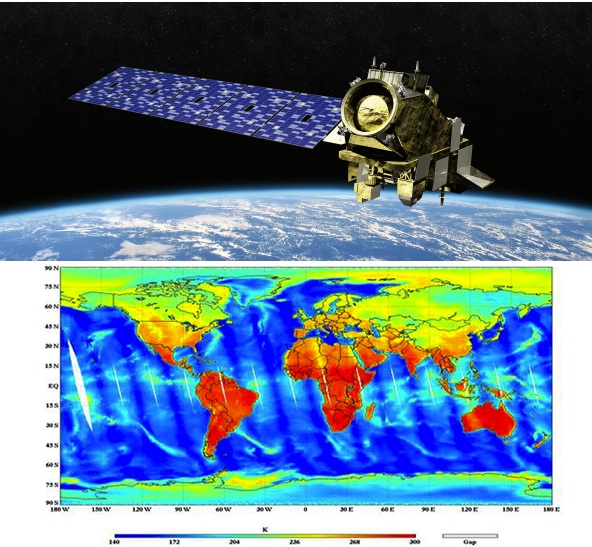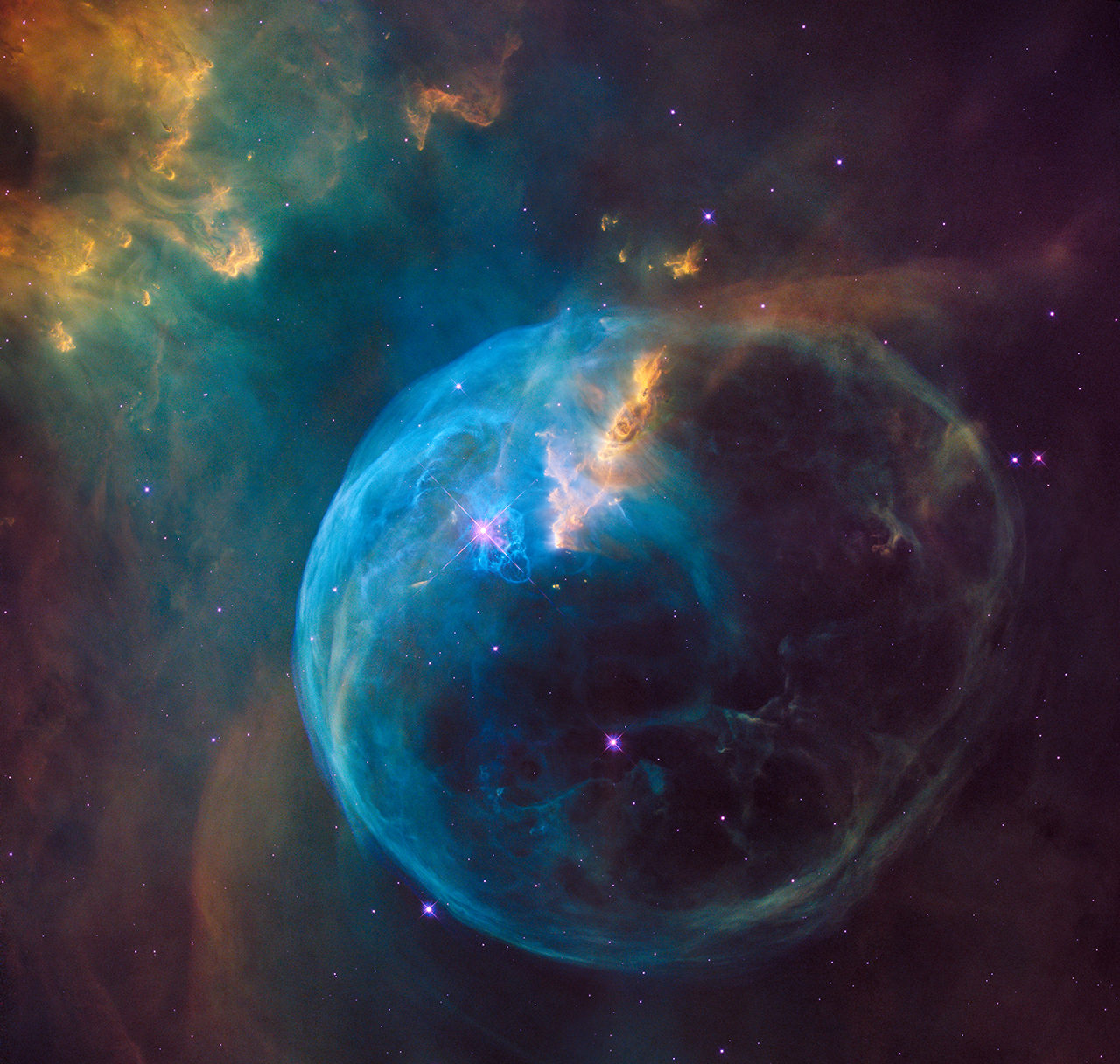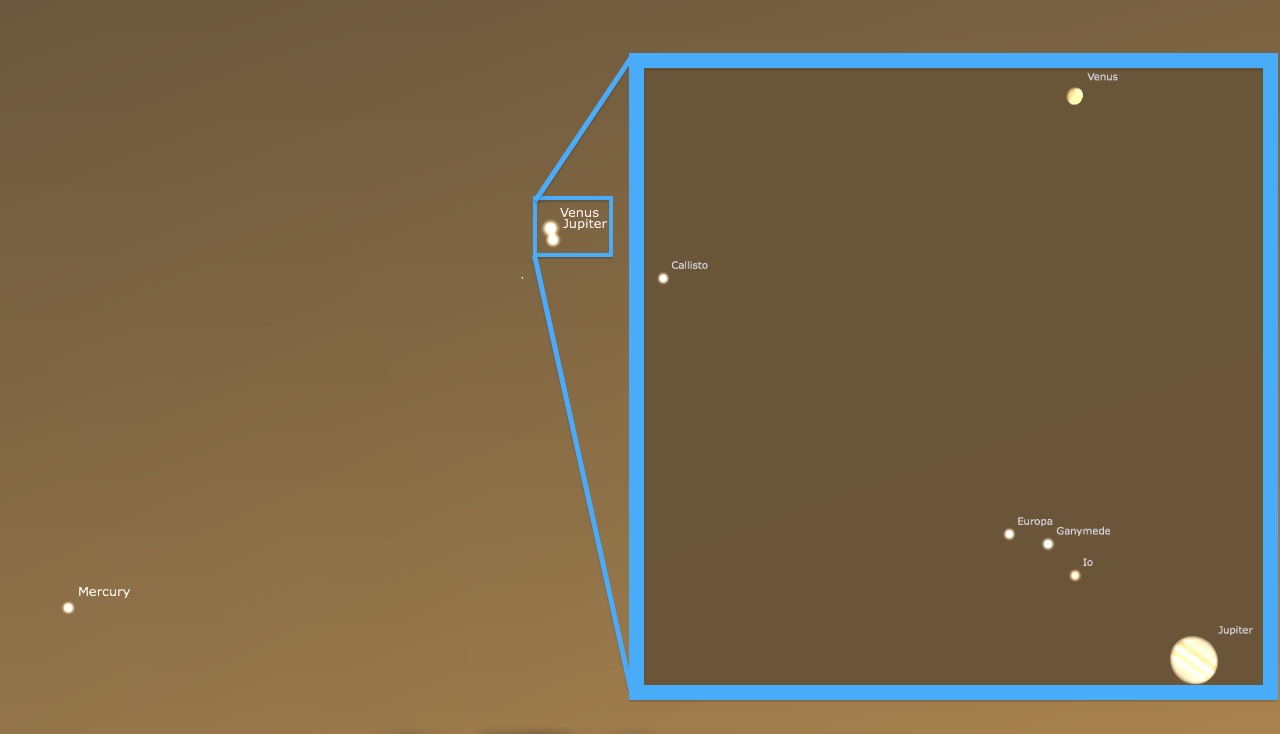Next Launch
Total Students
2,609
Total Launches
683
Eggs Survived
418 61.2%
Rockets Survived
536 78.5%
April 1, 2016
Hubble Shatters The Cosmic Record For Most Distant Galaxy
by Ethan Siegel
The farther away you look in the distant universe, the harder it is to see what's out there. This isn't simply because more distant objects appear fainter, although that's true. It isn't because the universe is expanding, and so the light has farther to go before it reaches you, although that's true, too. The reality is that if you built the largest optical telescope you could imagine -- even one that was the size of an entire planet -- you still wouldn't see the new cosmic record-holder that Hubble just discovered: galaxy GN-z11, whose light traveled for 13.4 billion years, or 97% the age of the universe, before finally reaching our eyes.
There were two special coincidences that had to line up for Hubble to find this: one was a remarkable technical achievement, while the other was pure luck. By extending Hubble's vision away from the ultraviolet and optical and into the infrared, past 800 nanometers all the way out to 1.6 microns, Hubble became sensitive to light that was severely stretched and redshifted by the expansion of the universe. The most energetic light that hot, young, newly forming stars produce is the Lyman-? line, which is produced at an ultraviolet wavelength of just 121.567 nanometers. But at high redshifts, that line passed not just into the visible but all the way through to the infrared, and for the newly discovered galaxy, GN-z11, its whopping redshift of 11.1 pushed that line all the way out to 1471 nanometers, more than double the limit of visible light!
Hubble itself did the follow-up spectroscopic observations to confirm the existence of this galaxy, but it also got lucky: the only reason this light was visible is because the region of space between this galaxy and our eyes is mostly ionized, which isn't true of most locations in the universe at this early time! A redshift of 11.1 corresponds to just 400 million years after the Big Bang, and the hot radiation from young stars doesn't ionize the majority of the universe until 550 million years have passed. In most directions, this galaxy would be invisible, as the neutral gas would block this light, the same way the light from the center of our galaxy is blocked by the dust lanes in the galactic plane. To see farther back, to the universe's first true galaxies, it will take the James Webb Space Telescope. Webb's infrared eyes are much less sensitive to the light-extinction caused by neutral gas than instruments like Hubble. Webb may reach back to a redshift of 15 or even 20 or more, and discover the true answer to one of the universe's greatest mysteries: when the first galaxies came into existence!
This article is provided by NASA Space Place. With articles, activities, crafts, games, and lesson plans, NASA Space Place encourages everyone to get excited about science and technology. Visit spaceplace.nasa.gov to explore space and Earth science!
This article was provided by the Jet Propulsion Laboratory, California Institute of Technology, under a contract with the National Aeronautics and Space Administration.
 Images credit: (top); NASA, ESA, P. Oesch (Yale University), G. Brammer (STScI), P. van Dokkum (Yale University), and G. Illingworth (University of California, Santa Cruz) (bottom), of the galaxy GN-z11, the most distant and highest-redshifted galaxy ever discovered and spectroscopically confirmed thus far.
Images credit: (top); NASA, ESA, P. Oesch (Yale University), G. Brammer (STScI), P. van Dokkum (Yale University), and G. Illingworth (University of California, Santa Cruz) (bottom), of the galaxy GN-z11, the most distant and highest-redshifted galaxy ever discovered and spectroscopically confirmed thus far.
May 1, 2016
NOAA's Joint Polar Satellite System (JPSS) to revolutionize Earth-watching
by Ethan Siegel
If you want to collect data with a variety of instruments over an entire planet as quickly as possible, there are two trade-offs you have to consider: how far away you are from the world in question, and what orientation and direction you choose to orbit it. For a single satellite, the best of all worlds comes from a low-Earth polar orbit, which does all of the following:
- orbits the Earth very quickly: once every 101 minutes,
- is close enough at 824 km high to take incredibly high-resolution imagery,
- has five separate instruments each probing various weather and climate phenomena,
- and is capable of obtaining full-planet coverage every 12 hours.
- The Cross-track Infrared Sounder (CrIS), which will measure the 3D structure of the atmosphere, water vapor and temperature in over 1,000 infrared spectral channels. This instrument is vital for weather forecasting up to seven days in advance of major weather events.
- The Advanced Technology Microwave Sounder (ATMS), which assists CrIS by adding 22 microwave channels to improve temperature and moisture readings down to 1 Kelvin accuracy for tropospheric layers.
- The Visible Infrared Imaging Radiometer Suite (VIIRS) instrument, which takes visible and infrared pictures at a resolution of just 400 meters (1312 feet), enables us to track not just weather patterns but fires, sea temperatures, nighttime light pollution as well as ocean-color observations.
- The Ozone Mapping and Profiler Suite (OMPS), which measures how the ozone concentration varies with altitude and in time over every location on Earth's surface. This instrument is a vital tool for understanding how effectively ultraviolet light penetrates the atmosphere.
- Finally, the Clouds and the Earth's Radiant System (CERES) will help understand the effect of clouds on Earth's energy balance, presently one of the largest sources of uncertainty in climate modeling.
This article is provided by NASA Space Place. With articles, activities, crafts, games, and lesson plans, NASA Space Place encourages everyone to get excited about science and technology. Visit spaceplace.nasa.gov to explore space and Earth science!
This article was provided by the Jet Propulsion Laboratory, California Institute of Technology, under a contract with the National Aeronautics and Space Administration.
 Images credit: an artist's concept of the JPSS-2 Satellite for NOAA and NASA by Orbital ATK (top); complete temperature map of the world from NOAA's National Weather Service (bottom).
Images credit: an artist's concept of the JPSS-2 Satellite for NOAA and NASA by Orbital ATK (top); complete temperature map of the world from NOAA's National Weather Service (bottom).
June 1, 2016
Hubble's bubble lights up the interstellar rubble
by Ethan Siegel
When isolated stars like our Sun reach the end of their lives, they're expected to blow off their outer layers in a roughly spherical configuration: a planetary nebula. But the most spectacular bubbles don't come from gas-and-plasma getting expelled into otherwise empty space, but from young, hot stars whose radiation pushes against the gaseous nebulae in which they were born. While most of our Sun's energy is found in the visible part of the spectrum, more massive stars burn at hotter temperatures, producing more ionizing, ultraviolet light, and also at higher luminosities. A star some 40-45 times the mass of the Sun, for example, might emits energy at a rate hundreds of thousands of times as great as our own star.
The Bubble Nebula, discovered in 1787 by William Herschel, is perhaps the classic example of this phenomenon. At a distance of 7,100 light years away in the constellation of Cassiopeia, a molecular gas cloud is actively forming stars, including the massive O-class star BD+60 2522, which itself is a magnitude +8.7 star despite its great distance and its presence in a dusty region of space. Shining with a temperature of 37,500 K and a luminosity nearly 400,000 times that of our Sun, it ionizes and evaporates off all the molecular material within a sphere 7 light years in diameter. The bubble structure itself, when viewed from a dark sky location, can be seen through an amateur telescope with an aperture as small as 8" (20 cm).
As viewed by Hubble, the thickness of the bubble wall is both apparent and spectacular. A star as massive as the one creating this bubble emits stellar winds at approximately 1700 km/s, or 0.6% the speed of light. As those winds slam into the material in the interstellar medium, they push it outwards. The bubble itself appears off-center from the star due to the asymmetry of the surrounding interstellar medium with a greater density of cold gas on the "short" side than on the longer one. The blue color is due to the emission from partially ionized oxygen atoms, while the cooler yellow color highlights the dual presence of hydrogen (red) and nitrogen (green).
The star itself at the core of the nebula is currently fusing helium at its center. It is expected to live only another 10 million years or so before dying in a spectacular Type II supernova explosion.
This article is provided by NASA Space Place. With articles, activities, crafts, games, and lesson plans, NASA Space Place encourages everyone to get excited about science and technology. Visit spaceplace.nasa.gov to explore space and Earth science!
This article was provided by the Jet Propulsion Laboratory, California Institute of Technology, under a contract with the National Aeronautics and Space Administration.
 Image credit: NASA, ESA, and the Hubble Heritage Team (STScI/AURA), of the Bubble Nebula as imaged 229 years after its discovery by William Herschel.
Image credit: NASA, ESA, and the Hubble Heritage Team (STScI/AURA), of the Bubble Nebula as imaged 229 years after its discovery by William Herschel.
July 1, 2016
Venus and Jupiter prepare for their close-up this August
by Ethan Siegel
As Earth speeds along in its annual journey around the Sun, it consistently overtakes the slower-orbiting outer planets, while the inner worlds catch up to and pass Earth periodically. Sometime after an outer world--particularly a slow-moving gas giant--gets passed by Earth, it appears to migrate closer and closer to the Sun, eventually appearing to slip behind it from our perspective. If you've been watching Jupiter this year, it's been doing exactly that, moving consistently from east to west and closer to the Sun ever since May 9th.
On the other hand, the inner worlds pass by Earth. They speed away from us, then slip behind the Sun from west to east, re-emerging in Earth's evening skies to the east of the Sun. Of all the planets visible from Earth, the two brightest are Venus and Jupiter, which experience a conjunction from our perspective only about once per year. Normally, Venus and Jupiter will appear separated by approximately 0.5º to 3º at closest approach. This is due to the fact that the Solar System's planets don't all orbit in the same perfect, two-dimensional plane.
But this summer, as Venus emerges from behind the Sun and begins catching up to Earth, Jupiter falls back toward the Sun, from Earth's perspective, at the same time. On August 27th, all three planets--Earth, Venus and Jupiter--will make nearly a perfectly straight line.
As a result, Venus and Jupiter, at 9:48 PM Universal time, will appear separated by only 4 arc-minutes, the closest conjunction of naked eye planets since the Venus/Saturn conjunction in 2006. Seen right next to one another, it's startling how much brighter Venus appears than Jupiter; at magnitude -3.80, Venus appears some eight times brighter than Jupiter, which is at magnitude -1.53.
Look to the western skies immediately after sunset on August 27th, and the two brightest planets of all--brighter than all the stars--will make a dazzling duo in the twilight sky. As soon as the sun is below the horizon, the pair will be about two fists (at arm's length) to the left of the sun's disappearance and about one fist above a flat horizon. You may need binoculars to find them initially and to separate them. Through a telescope, a large, gibbous Venus will appear no more distant from Jupiter than Callisto, its farthest Galilean satellite.
As a bonus, Mercury is nearby as well. At just 5º below and left of the Venus/Jupiter pair, Mercury achieved a distant conjunction with Venus less than 24 hours prior. In 2065, Venus will actually occult Jupiter, passing in front of the planet's disk. Until then, the only comparably close conjunctions between these two worlds occur in 2039 and 2056, meaning this one is worth some special effort--including traveling to get clear skies and a good horizon--to see!
To learn more about Venus and Jupiter, visit the NASA Space Place webpages titled "All About Venus" [http://spaceplace.nasa.gov/all-about-venus/en/] and "All About Jupiter" [http://spaceplace.nasa.gov/all-about-jupiter/en/].
This article is provided by NASA Space Place. With articles, activities, crafts, games, and lesson plans, NASA Space Place encourages everyone to get excited about science and technology. Visit spaceplace.nasa.gov to explore space and Earth science!
This article was provided by the Jet Propulsion Laboratory, California Institute of Technology, under a contract with the National Aeronautics and Space Administration.
 Image credit: E. Siegel, created with Stellarium, of a small section of the western skies as they will appear this August 27th just after sunset from the United States, with Venus and Jupiter separated by less than 6 arc-minutes as shown. Inset shows Venus and Jupiter as they'll appear through a very good amateur telescope, in the same field of view.
Image credit: E. Siegel, created with Stellarium, of a small section of the western skies as they will appear this August 27th just after sunset from the United States, with Venus and Jupiter separated by less than 6 arc-minutes as shown. Inset shows Venus and Jupiter as they'll appear through a very good amateur telescope, in the same field of view.